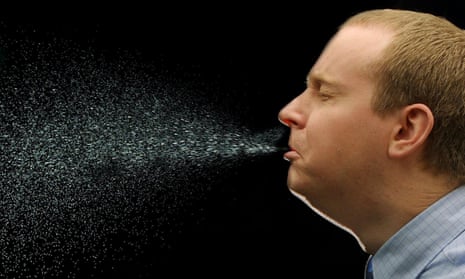In a season where colds are rife, holding your nose and closing your mouth might seem like a considerate alternative to an explosive “Achoo!”. But doctors have warned of the dangers of such a move after a man was found to have ruptured the back of his throat when attempting to stifle a sneeze.
Medics say the incident, which they detail in the journal BMJ Case Reports, came to light when a 34-year old man arrived in A&E with a change to his voice, a swollen neck, pain when swallowing and a popping sensation in his neck after he pinched his nose to contain an expulsion.
The team took scans of the man’s neck to investigate and discovered bubbles of air in the tissues at the back of the throat, and in the neck from the base of the skull to halfway down the man’s back.
That, they say, suggested a tear had occurred at the back of the throat as a result of increased pressure from the stifled sneeze, leading to air collecting in his soft tissues.
“For reasons of propriety and etiquette, one sometimes stops a sneeze. However on unfortunate rare occasions it might lead to potentially serious complications,” said Dr Sudip Das, co-author of the report from the University Hospitals of Leicester NHS Trust.
The authors warn that blocking the nostrils and mouth when sneezing is dangerous, noting that while tearing of the throat tissue is rare, it could result in a ruptured eardrum or even a brain aneurysm.
“Spontaneous perforation of the throat with leakage of air under the skin is very rare,” said Das, although he noted that there had been cases before.
Mr Shahz Ahmed, an ENT consultant and skull base surgeon at University Hospital Birmingham who was not involved in the case, added that such complications from sneezing were so uncommon that there was no evidence in general that individuals should not hold one in.
Das and colleagues add that similar complications canoccur if the lower portion of the oesophagus tears, a serious and potentially fatal situation that can be triggered, among other causes, by retching and vomiting. “Any cause of increase in pressure in a closed throat, viz severe coughing or vomiting, can cause the symptoms,” said Vas. “A known weakness in the wall of the voice box, throat, gullet or the lung may predispose the patient to such complications.” But, he added, “even then the condition is rare.”
The patient was admitted to hospital and given intravenous antibiotics to prevent infection and was tube-fed to aid healing, with scans a week later showing no signs of air bubbles. “The patient was subsequently discharged with advice to avoid obstructing both nostrils while sneezing,” they write.

Comments (…)
Sign in or create your Guardian account to join the discussion